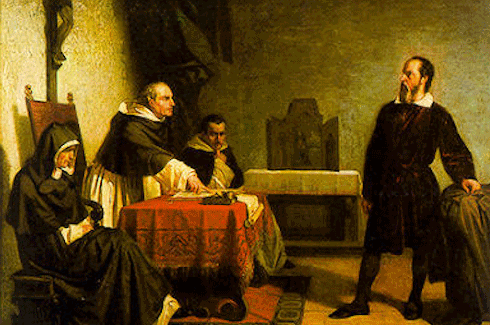“The Lord set the earth on its foundations; it can never be moved”
– Psalm 104:5
The Bible includes numerous assertions about geocentrism — the idea that Earth is the center of the universe. In the early 16th century, when the Renaissance astronomer Galileo Galilei defended the Copernican concept of heliocentrism — the idea that Earth revolves around the Sun — and claimed that it was not contrary to Scripture, Cardinal Roberto Bellarmine ordered him to abandon this “heretical” concept. But Galileo kept on promoting the theory of heliocentrism, which he discussed in his 1632 text “Dialogue Concerning the Two Chief World Systems.”
Cardinal Bellarmine’s actions provide a documented historical incidence of a dopamine addict’s 3-D cycle. His addiction to the D-needs of safety, approval, and esteem kept Bellarmine trapped in a downward spiral of dopamine, deception, and dehumanization.
Bellarmine was a high-ranking Church official because he was a dopamine addict. Healthy individuals do not crave power. Bellarmine’s need for power is the reason he was in a position to interfere with the natural progression of science, logic, and human evolution on behalf of an addiction that does not tolerate any threats to dopamine flow. Bellarmine might have genuinely believed the delusion about being a man of God. But that’s only because his delusions came with massive dopamine hits – as did his addiction to the safety, peer-approval, and esteem-related dopamine hits still afforded today’s clerics.
Galileo chased around Europe to locate the inventor of the telescope, then taught himself to grind the lenses that proved his insights. All he asked of Cardinal Bellarmine was for him to look through the eyepiece. But Bellarmine wasn’t interested in seeing anything that threatened to reduce him from a revered cardinal into a scorned buffoon. Not that he would have minded being a scorned buffoon if it triggered enough dopamine.
When evaluated in terms of brain chemistry, Bellarmine’s actions had nothing to do with a vengeful God, religion, dedication, right, wrong, intelligence, or facts. They had everything to do with protecting job security, peer approval, and social status. Bellarmine was just an obnoxious member of a private boys’ club made up of dopamine addicts who signed on to a brilliant scam. In effect, the College of Cardinals backing Bellarmine was nothing more than a gang of unwitting colluders who joined forces to protect each other’s dopamine flow. The fact that they were too lost in a communal dopamine haze to notice what they were really doing was both inconsequential and the key to their success.
The Galileo Affair provides an excellent example of how a powerful organization headed by run-amuck dopamine addicts used its resources to silence one, rare, reasoning individual. It leaves us wondering about the countless times when unreasoning, unreasonable, ruthless addicts prevailed by making sure that no witnesses were left to report what happened.
The College of Cardinals showed how the most diseased dopamine addicts strive for positions of power and how peer-approval addictions can keep supposedly intelligent men from noticing, questioning, or challenging one another’s hypocrisies, injustices, and deceptions.
Throughout the ages organized religions revealed why hypocritical, self-deceptive cabals of colluding addicts are so threatened by geniuses. Galileo epitomized why geniuses want nothing to do with addicts. His clash shows how organized dopamine addicts obsess over protecting their dopamine sources and how their addictions have been thwarting human evolution since long before recorded history.





Discussion
Comments are closed.